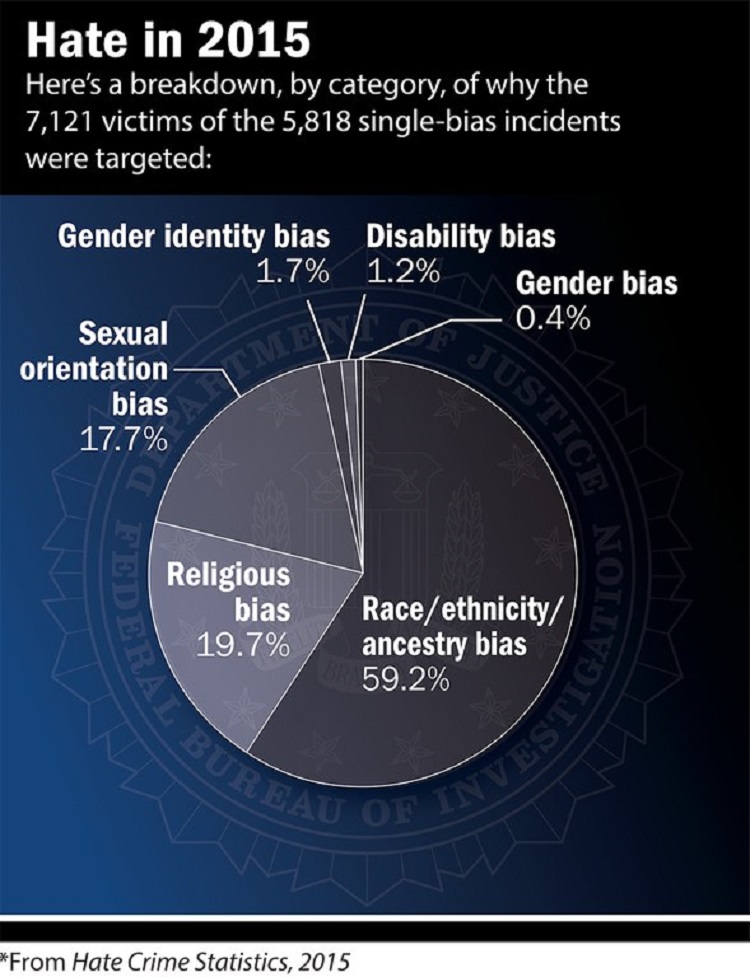Washington, DC - November 14, 2016 - Earlier this year, a Florida man pled guilty to threatening to firebomb two mosques. A Virginia man was charged with assaulting a gay victim. And an Iowa man was convicted of stomping on and kicking the head of an African-American victim.
Hate crimes like these can have a devastating impact upon the communities where they occur, which is one of the reasons why the investigation of hate crimes that fall under federal jurisdiction is the number one priority under the FBI’s civil rights program.
But in addition to its investigative work, the FBI gathers and publishes—through its Uniform Crime Reporting Program—hate crime statistics from law enforcement agencies across the country to help provide an accurate accounting of the problem, by state and nationally. And today, the Bureau released its latest Hate Crime Statistics report—this one containing data for 2015—that includes information detailing the offenses, victims, offenders, and locations of hate crimes. The 2015 collection marks the 25th anniversary of the Bureau’s work to compile data about bias-motivated crimes, which began in 1990.
This year’s report, which contains data from 14,997 law enforcement agencies, reveals 5,850 criminal incidents and 6,885 related offenses that were motivated by bias against race, ethnicity, ancestry, religion, sexual orientation, disability, gender, and gender identity.

Additional findings in Hate Crime Statistics, 2015 include the following:
- There were 5,818 single-bias incidents involving 7,121 victims. Of those victims, 59.2 percent were targeted because of a race/ethnicity/ancestry bias; 19.7 percent because of a religious bias; 17.7 percent because of a sexual orientation bias; 1.7 percent because of a gender identity bias; 1.2 percent because of a disability bias; and 0.4 percent because of a gender bias.
- There were an additional 32 multiple-bias incidents that involved another 52 victims.
- Of the 4,482 hate crime offenses classified as crimes against persons, intimidation accounted for 41.3 percent of those offenses, while 37.8 percent involved simple assault and 19.7 percent involved aggravated assault.
- There were 2,338 hate crime offenses classified as crimes against property, and the majority of those (72.6 percent) were acts of destruction/damage/vandalism.
- During 2015, most reported hate crime incidents (31.5 percent) happened in or near residences or homes.
- Of the 5,493 known offenders, 48.4 percent were white, 24.3 percent were black or African-American, and race was unknown for 16.2 percent of the offenders. The rest were of various other races.
New to the 2015 Hate Crime Statistics report is the inclusion of seven additional religious anti-bias categories (anti-Buddhist, anti-Eastern Orthodox, anti-Hindu, anti-Jehovah’s Witness, anti-Mormon, anti-other Christian, and anti-Sikh), as well as an anti-Arab bias motivation.
Importance of Reporting Hate Crime Data
In 1990, Congress passed the Hate Crime Statistics Act, which required the attorney general to collect data “about crimes which manifest evidence of prejudice based on race, religion, sexual orientation, or ethnicity.” The attorney general delegated the responsibility to the Director of the FBI, who, in turn, assigned the task to the Bureau’s Uniform Crime Reporting (UCR) Program.
Since then, additional categories have been added in an effort to improve the quality of the data collected. The more detailed we can be with the collection, the better all of law enforcement can detect trends and add necessary resources to combat these crimes.
But the FBI’s annual Hate Crime Statistics report is only as good as the information it contains, and increased participation from law enforcement agencies will provide a more complete picture of hate crime in America. Recently, the International Association of Chiefs of Police—with the assistance of the Anti-Defamation League—issued a model policy for law enforcement agencies around the country on the investigation of hate crimes. The IACP also encouraged each agency to develop a standard for collecting, analyzing, and reporting incidents of hate crime—and, in particular, to submit monthly reports on all hate crime occurrences to the UCR Program.
According to FBI Director James Comey, “We need to do a better job of tracking and reporting hate crime to fully understand what is happening in our communities and how to stop it.”
Full report: Hate Crime Statistics, 2015










